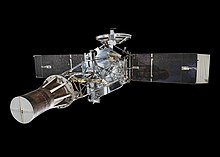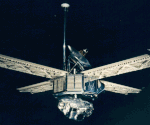
Mariner 4 was the fourth in a series of spacecraft intended for planetary exploration in a flyby mode. It was designed to conduct closeup scientific observations of Mars and to transmit these observations to Earth. Launched on November 28, 1964, Mariner 4 performed the first successful flyby of the planet Mars, returning the first close-up pictures of the Martian surface. It captured the first images of another planet ever returned from deep space; their depiction of a cratered, dead planet largely changed the scientific community's view of life on Mars. Other mission objectives were to perform field and particle measurements in interplanetary space in the vicinity of Mars and to provide experience in and knowledge of the engineering capabilities for interplanetary flights of long duration. Initially expected to remain in space for eight months, Mariner 4's mission lasted about three years in solar orbit. On December 21, 1967, communications with Mariner 4 were terminated.

Space exploration is the use of astronomy and space technology to explore outer space. While the exploration of space is currently carried out mainly by astronomers with telescopes, its physical exploration is conducted both by uncrewed robotic space probes and human spaceflight. Space exploration, like its classical form astronomy, is one of the main sources for space science.

Voyager 1 is a space probe launched by NASA on September 5, 1977, as part of the Voyager program to study the outer Solar System and the interstellar space beyond the Sun's heliosphere. It was launched 16 days after its twin Voyager 2. It communicates through the NASA Deep Space Network (DSN) to receive routine commands and to transmit data to Earth. Real-time distance and velocity data is provided by NASA and JPL. At a distance of 163 AU from Earth as of January 2024, it is the most distant human-made object from Earth.

Mariner 9 was a robotic spacecraft that contributed greatly to the exploration of Mars and was part of the NASA Mariner program. Mariner 9 was launched toward Mars on May 30, 1971, from LC-36B at Cape Canaveral Air Force Station, Florida, and reached the planet on November 14 of the same year, becoming the first spacecraft to orbit another planet – only narrowly beating the Soviet probes Mars 2 and Mars 3, which both arrived at Mars only weeks later.

Mariner 2, an American space probe to Venus, was the first robotic space probe to report successfully from a planetary encounter. The first successful spacecraft in the NASA Mariner program, it was a simplified version of the Block I spacecraft of the Ranger program and an exact copy of Mariner 1. The missions of the Mariner 1 and 2 spacecraft are sometimes known as the Mariner R missions. Original plans called for the probes to be launched on the Atlas-Centaur, but serious developmental problems with that vehicle forced a switch to the much smaller Agena B second stage. As such, the design of the Mariner R vehicles was greatly simplified. Far less instrumentation was carried than on the Soviet Venera probes of this period—for example, forgoing a TV camera—as the Atlas-Agena B had only half as much lift capacity as the Soviet 8K78 booster. The Mariner 2 spacecraft was launched from Cape Canaveral on August 27, 1962, and passed as close as 34,773 kilometers (21,607 mi) to Venus on December 14, 1962.

Mariner 6 and Mariner 7 were two uncrewed NASA robotic spacecraft that completed the first dual mission to Mars in 1969 as part of NASA's wider Mariner program. Mariner 6 was launched from Launch Complex 36B at Cape Canaveral Air Force Station and Mariner 7 from Launch Complex 36A. The two craft flew over the equator and south polar regions, analyzing the atmosphere and the surface with remote sensors, and recording and relaying hundreds of pictures. The mission's goals were to study the surface and atmosphere of Mars during close flybys, in order to establish the basis for future investigations, particularly those relevant to the search for extraterrestrial life, and to demonstrate and develop technologies required for future Mars missions. Mariner 6 also had the objective of providing experience and data which would be useful in programming the Mariner 7 encounter five days later.

Mariner 10 was an American robotic space probe launched by NASA on 3 November 1973, to fly by the planets Mercury and Venus. It was the first spacecraft to perform flybys of multiple planets.

Mariner 1, built to conduct the first American planetary flyby of Venus, was the first spacecraft of NASA's interplanetary Mariner program. Developed by Jet Propulsion Laboratory, and originally planned to be a purpose-built probe launched summer 1962, Mariner 1's design was changed when the Centaur proved unavailable at that early date. Mariner 1, were then adapted from the lighter Ranger lunar spacecraft. Mariner 1 carried a suite of experiments to determine the temperature of Venus as well to measure magnetic fields and charged particles near the planet and in interplanetary space.

Venera 1, also known as Venera-1VA No.2 and occasionally in the West as Sputnik 8 was the first spacecraft to perform an interplanetary flight and the first to fly past Venus, as part of the Soviet Union's Venera programme. Launched in February 1961, it flew past Venus on 19 May of the same year; however, radio contact with the probe was lost before the flyby, resulting in it returning no data.

A gravity assist, gravity assist maneuver, swing-by, or generally a gravitational slingshot in orbital mechanics, is a type of spaceflight flyby which makes use of the relative movement and gravity of a planet or other astronomical object to alter the path and speed of a spacecraft, typically to save propellant and reduce expense.
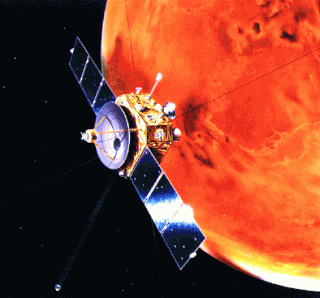
Nozomi was a Japanese Mars orbiter that failed to reach Mars due to electrical failure. It was constructed by the Institute of Space and Astronautical Science, University of Tokyo and launched on July 4, 1998, at 03:12 JST with an on-orbit dry mass of 258 kg and 282 kg of propellant. The Nozomi mission was terminated on December 31, 2003.

Mariner Mark II was NASA's planned family of uncrewed spacecraft for the exploration of the outer Solar System that were to be developed and operated by JPL between 1980 through the year 2010.
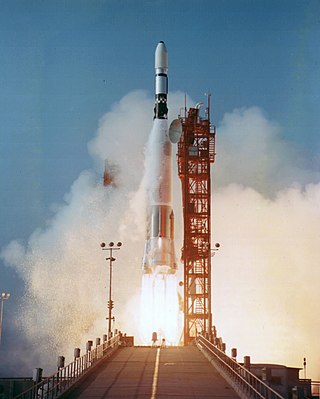
The Atlas-Agena was an American expendable launch system derived from the SM-65 Atlas missile. It was a member of the Atlas family of rockets, and was launched 109 times between 1960 and 1978. It was used to launch the first five Mariner uncrewed probes to the planets Venus and Mars, and the Ranger and Lunar Orbiter uncrewed probes to the Moon. The upper stage was also used as an uncrewed orbital target vehicle for the Gemini crewed spacecraft to practice rendezvous and docking. However, the launch vehicle family was originally developed for the Air Force and most of its launches were classified DoD payloads.

The exploration of Mercury has a minor role in the space interests of the world. It is the least explored inner planet. As of 2015, the Mariner 10 and MESSENGER missions have been the only missions that have made close observations of Mercury. MESSENGER made three flybys before entering orbit around Mercury. A third mission to Mercury, BepiColombo, a joint mission between the Japan Aerospace Exploration Agency (JAXA) and the European Space Agency, is to include two probes. MESSENGER and BepiColombo are intended to gather complementary data to help scientists understand many of the mysteries discovered by Mariner 10's flybys.

The exploration of Uranus has, to date, been through telescopes and a lone probe by NASA's Voyager 2 spacecraft, which made its closest approach to Uranus on January 24, 1986. Voyager 2 discovered 10 moons, studied the planet's cold atmosphere, and examined its ring system, discovering two new rings. It also imaged Uranus' five large moons, revealing that their surfaces are covered with impact craters and canyons.
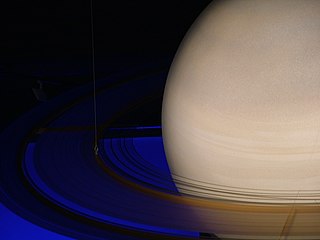
The exploration of Saturn has been solely performed by crewless probes. Three missions were flybys, which formed an extended foundation of knowledge about the system. The Cassini–Huygens spacecraft, launched in 1997, was in orbit from 2004 to 2017.

OCEANUS is a mission concept conceived in 2016 and presented in 2017 as a potential future contestant as a New Frontiers program mission to the planet Uranus. The concept was developed by the Astronautical engineering students of Purdue University during the 2017 NASA/JPL Planetary Science Summer School. OCEANUS is an orbiter, which would enable a detailed study of the structure of the planet's magnetosphere and interior structure that would not be possible with a flyby mission.


